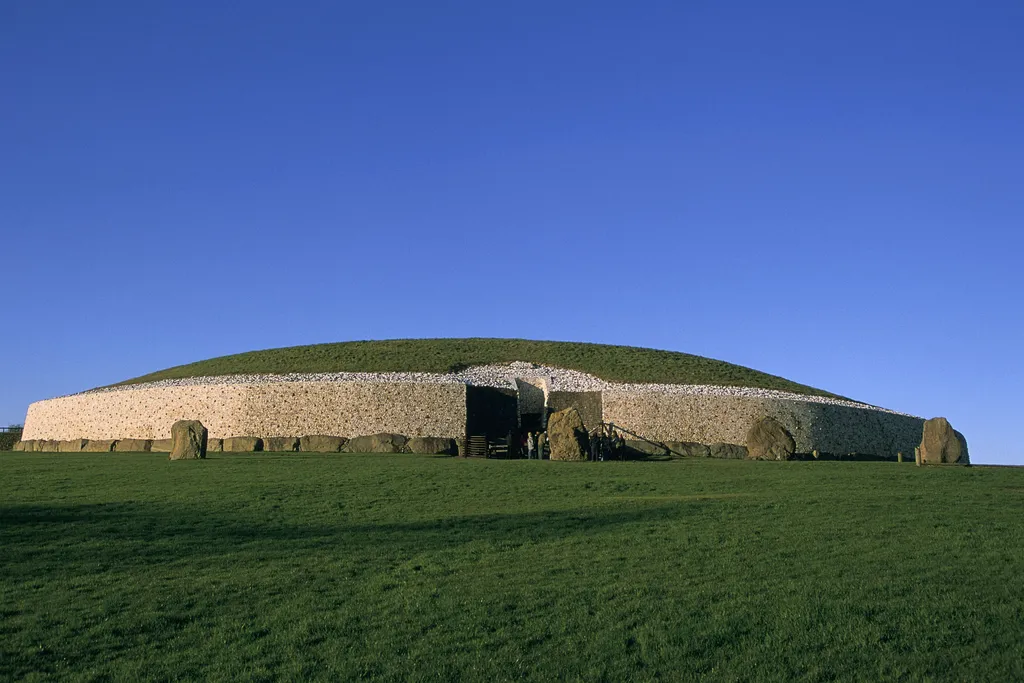These Massive Monuments Hosted Community Gatherings Where Prehistoric People Mingled, Feasted and Buried Their Dead
These Massive Monuments Hosted Community Gatherings Where Prehistoric People Mingled, Feasted and Buried Their Dead
A new study contradicts the long-held assumption that Ireland’s Neolithic passage tombs were reserved for members of an elite ruling family
Newgrange is one of Ireland's most famous Neolithic passage tombs.
Jean-Patrick DEYA / Gamma-Rapho via Getty Images
Ireland’s lush, green landscapes are dotted with Stone Age tombs, with some burial sites dating back 5,000 years.
Archaeologists have long puzzled over these mysterious graves, wondering who was buried in them and what roles they played in Neolithic societies.
Now, they may finally have some answers to these questions.
A new analysis of ancient DNA and archaeological data suggests Ireland’s “passage tombs”—large circular mounds with narrow entrances—likely served as community gathering spaces, according to a paper published earlier this month in the Cambridge Archaeological Journal.
“These monuments were about so much more than burial,” lead author Neil Carlin, an archaeologist at University College Dublin, tells Tom Dunne, host of the “Moncrieff Highlights” podcast. “Their whole architecture is about ceremony, it’s about facilitating ongoing interaction. … For centuries afterward, people would enter these tombs, they would take bones out, they would put more bones in. It was all about ongoing and continuing engagement. Some of that has to do with remembrance [and] celebration at particular times of the year.”
Neolithic Sligo- the passage tombs of Carrowmore and Knocknarea.
Watch on
In addition, most of the individuals buried in Ireland’s Neolithic passage tombs were only distantly related—for example, they may have been second cousins or great-great-great-grandparents. Only smaller, earlier Neolithic tombs contained the remains of closely related family members.
“This tells us that burial [in the passage tombs] was not strongly determined by biological relatedness,” three of the study’s co-authors write in the Conversation.
The findings contradict the long-held assumption that Ireland’s Neolithic passage tombs were reserved for members of an elite ruling family, including some that had incestuous relationships. Instead, the co-authors suggest they were built for the community, and that Neolithic Ireland was “a more equal society,” Carlin tells Live Science’s Kristina Killgrove.
The analysis also offers new insights into broader lifestyle and relational shifts in Irish Neolithic society.
During the early part of the period, individuals lived in small, tight-knit communities. This arrangement was reflected in their tombs, which were small and simple; they also contained the remains of closely related family members.
A Neolithic tomb at Knowth in County Meath, Ireland
Sitomon via Wikimedia Commons under CC BY-SA 3.0
But around the year 3300 B.C.E., these small, simple burial sites gave way to passage tombs. These were much larger and more architecturally complex, and they were positioned in elevated, visible locations that were set away from settlements and pastures. Passage tombs also contained the remains of people who were less closely related and came from different parts of Ireland. This shift corresponds with a time when Neolithic individuals were becoming more mobile and their social networks were becoming larger.
Although the individuals buried in passage tombs were not close family members, they were more closely related to each other than to the wider Irish and British population at the time, according to the DNA analysis. Researchers suspect individuals formed a “genetic cluster” with other people who congregated at the passage tombs.
“They were places where people were coming together at particular times of the year, like the mid-winter solstice,” Carlin tells “Moncrieff Highlights.” “They were coming together, they were feasting, they were burying their dead, they were celebrating, they were having parties. And as part of that, they seem to have been choosing their reproductive partners. … It’s this idea that, because the social networks have been more expansive, people are choosing their partners from within this closer group, the people who share their beliefs [and] their worldview.”
However, the researchers found no evidence to suggest that marriages were based on status or rank.
“People met, mingled and had children with each other throughout the Irish Neolithic period, regardless of how they buried their dead,” the co-authors write in the Conversation.
Get the latest stories in your inbox every weekday.


